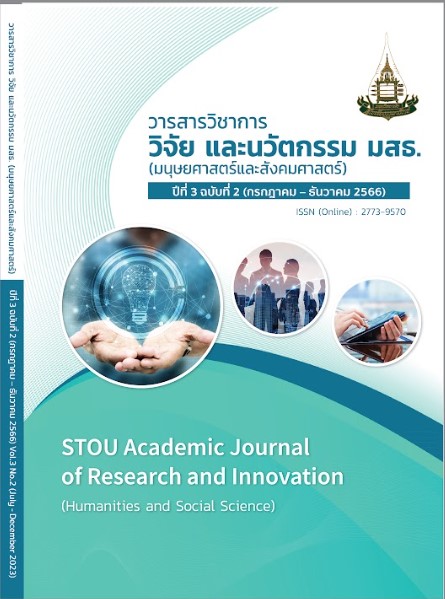การวัดผลการมีธรรมาภิบาลในสถาบันอุดมศึกษาไทย
Keywords:
Governance, Measurement, Thai Higher Education InstitutionsAbstract
Any organization needs good governance, but Higher Education Institutions (HEIs) need it more than all organization. Due to the complexity of HEIs and the wide range of stakeholders they involve, including students, teachers, staff, alumni, funders, and the general public, HEIs are held accountable for the results of their operations thanks to governance, which ensures that these stakeholders are included in the decision-making process. Effectiveness, accountability, equity, and openness are factors that encourage excellent governance at HEIs. The measurement of governance in Thai HEIs should be done in cooperate with people's awareness, process monitoring and control, and also the use of digital technology, which is person-centered and focuses on creating a stimulating atmosphere, and promote a trusting environment. Process management in accordance with The Education Criteria for Performance Excellence (EdPEx), edition 2020–2023, as it relates to the application of good governance at HEIs and the use of digital technology to collaborate, assign work, and keep track of initiatives. risk management strategy and action plan In addition to evaluating the benefits and openness of how government agencies operate, Thai HEIs can examine their good governance in other ways. Also referred to as an "integrity and transparency assessment" (ITA assessment), this evaluation considers the development of high-quality HEIs. The Financial Audit Report also discusses the findings of the external auditors' internal audit.
References
กรมบัญชีกลาง. (2554). มาตรฐานการตรวจสอบภายในและจริยธรรมการปฏิบัติงานตรวจสอบภายในของส่วนราชการ. กรมบัญชีกลาง.
กองแผนงาน มหาวิทยาลัยพะเยา. (2566). แผนยุทธศาสตร์การพัฒนามหาวิทยาลัยพะเยา ประจำปีงบประมาณ พ.ศ.2566 – 2570. มหาวิทยาลัยพะเยา.
กองนโยบายและแผน มหาวิทยาลัยราชภัฏสงขลา. (2561). แผนยุทธศาสตร์การพัฒนามหาวิทยาลัยราชภัฏสงขลา ระยะ 5 ปี (พ.ศ. 2561 – 2565). มหาวิทยาลัยราชภัฏสงขลา.
จุฬาลงกรณ์มหาวิทยาลัย. (2566). โครงสร้างองค์กร. สืบค้นจาก https://www.chula.ac.th/about/overview/organization-chart/
ธีรเสฏฐ์ ศิรธนานนท์. (2564). ยุทธศาสตร์การพัฒนาสถาบันอุดมศึกษาแห่งเมืองสำหรับสถาบันอุดมศึกษาในกำกับองค์กรปกครองส่วนท้องถิ่นรูปแบบพิเศษ. (ปริญญานิพนธ์ปริญญาดุษฎีบัณฑิต การจัดการการอุดมศึกษา). บัณฑิตวิทยาลัย สถาบันอุดมศึกษาศรีนครินทรวิโรฒ. กรุงเทพฯ.
แนวปฏิบัติตามหลักธรรมาภิบาลในสถาบันอุดมศึกษา. (2564). ราชกิจจานุเบกษา (เล่มที่ 138 ตอนพิเศษ 311ง, น. 23-35).
มหาวิทยาลัยเกษตรศาสตร์. (2566). โครงสร้างส่วนงานและหน่วยงานมหาวิทยาลัยเกษตรศาสตร์. สืบค้นจาก https://www.ku.ac.th/th/section-structure
มหาวิทยาลัยธรรมศาสตร์. (2566). แผนภูมิโครงสร้างหน่วยงานของมหาวิทยาลัยธรรมศาสตร์. สืบค้นจาก https://tu.ac.th/uploads/news-tu/news/2566/jan/file/organizatuon-chart-2023.pdf
มหาวิทยาลัยมหิดล. (2566). โครงสร้างองค์กร. สืบค้นจาก https://mahidol.ac.th/th/mahidol-organization/
มหาวิทยาลัยศรีนครินทรวิโรฒ. (2566). ส่วนงานภายใน. สืบค้นจาก http://council.swu.ac.th/Default.aspx?tabid=19518
มาตรฐานการจัดการศึกษาระดับอุดมศึกษา พ.ศ. 2565. (2565). ราชกิจจานุเบกษา (เล่มที่ 139 ตอนที่ 20ก, น. 3-11).
สำนักงานคณะกรรมการกำกับหลักทรัพย์และตลาดหลักทรัพย์. (2562). แนวทางธรรมาภิบาลของ ก.ล.ต. (ฉบับปรับปรุง พิมพ์ครั้งที่ 4). กรุงเทพฯ: สำนักงานคณะกรรมการกำกับหลักทรัพย์และตลาดหลักทรัพย์.
สำนักงานคณะกรรมการป้องกันและปราบปรามการทุจริตแห่งชาติ. (2566). คู่มือการประเมินคุณธรรมและความโปร่งใสในการดำเนินงานของหน่วยงานภาครัฐ ประจำปีงบประมาณ พ.ศ. 2566. นนทบุรี: กรังด์ปรีซ์อินเตอร์เนชั่นแนล.
สำนักงานคณะกรรมการพัฒนาระบบราชการ. (2566). หลักธรรมาภิบาลของการบริหารกิจการบ้านเมืองที่ดี. สืบค้นจาก https://www.ocsc.go.th/sites/default/files/attachment/article/7.1_ hlakthrrmaaphibaalkhngkaarbrihaarkicchkaarbaanemuuengthiidii.pdf
ส่วนนโยบายและแผน มหาวิทยาลัยแม่ฟ้าหลวง. (2566). คู่มือคำอธิบายตัวชี้วัดแผนพัฒนามหาวิทยาลัยแม่ฟ้าหลวง ฉบับที่ 5 (พ.ศ. 2565-2569) ฉบับแก้ไขค่าเป้าหมาย 2566. มหาวิทยาลัยแม่ฟ้าหลวง.
Barry, D., & Goedegebuure, L. (2018). Good Governance and Higher Education. In: Encyclopedia of International Higher Education Systems and Institutions. Springer, Dordrecht. https://doi.org/10.1007/978-94-017-9553-1_148-1
Nadler, D. A., & Tushman, M. L. (1997). The organization of the future: Redesign for the 21st century. San Francisco, CA: Jossey-Bass.
Smith, J. (2023). The People-Process-Technology (PPT) framework: A guide for improving organizational performance. Journal of Business and Management, 10(1), 1-10.
Weick, K. E., & Quinn, R. E. (1999). Organizational change and development (2nd ed.). New York, NY: McGraw-Hill.
World Economic Forum. (2023). From Davos 2022 to Davos 2023: The six themes then that have set the agenda now. Retrieved from https://www.weforum.org/agenda/2022/06/davos-2022-key-themes-global-cooperation-health-equity-digital-inclusion-economic-outlook/
World Economic Forum. (2020). Future of Jobs Report 2020 Retrieved from https://www3.weforum.org/docs/WEF_Future_of_Jobs_2020.pdf
Downloads
Published
How to Cite
Issue
Section
License
Copyright (c) 2023 STOU Academic Journal of Research and Innovation (Humanities and Social Science) (Online)

This work is licensed under a Creative Commons Attribution-NonCommercial-NoDerivatives 4.0 International License.





